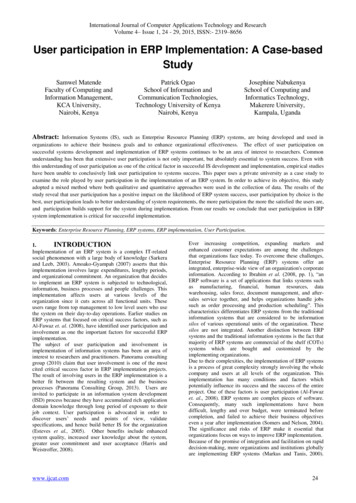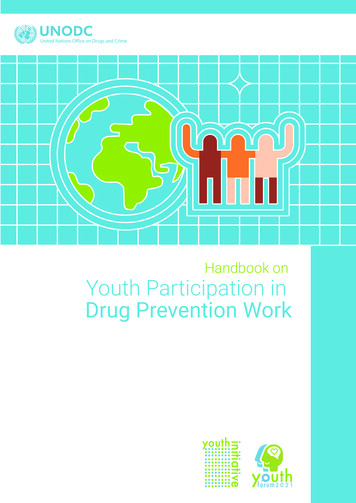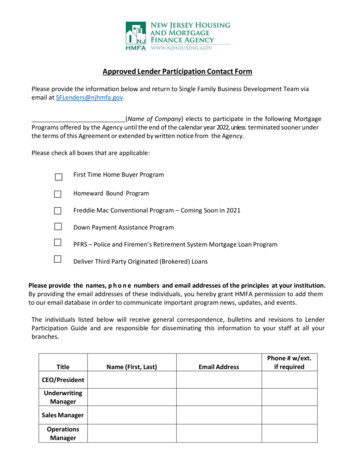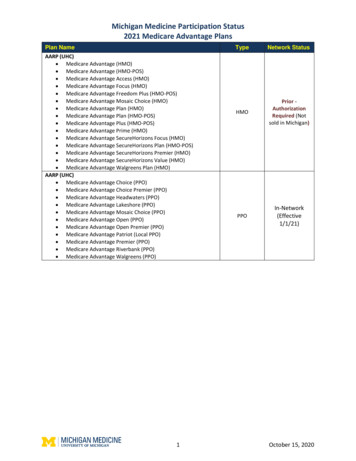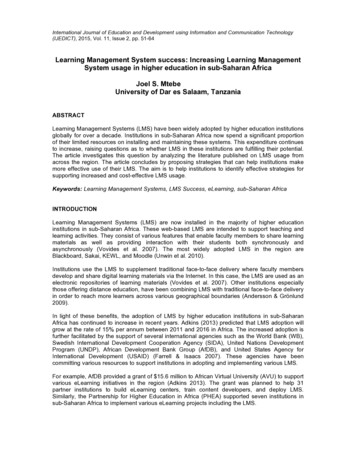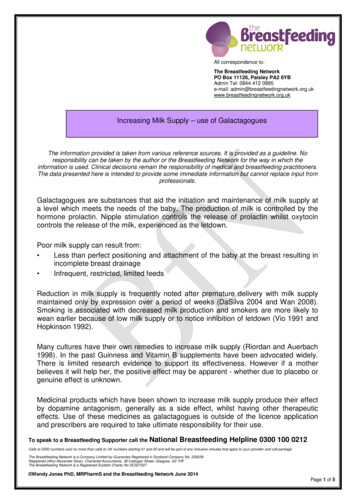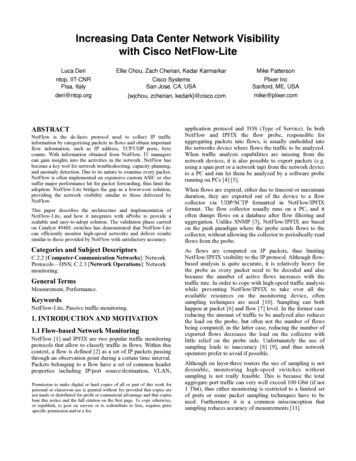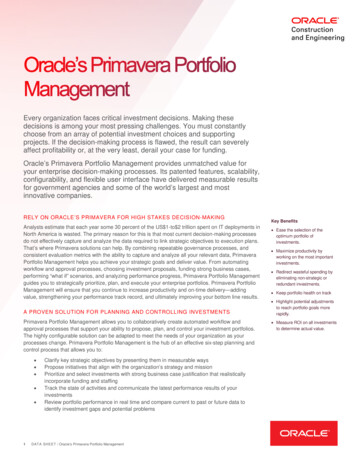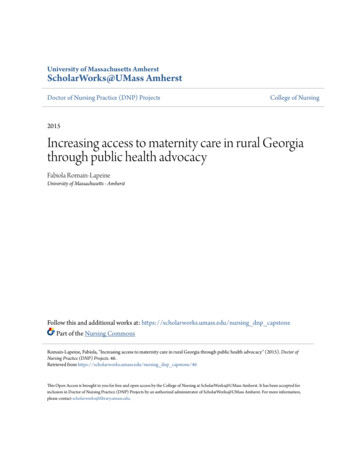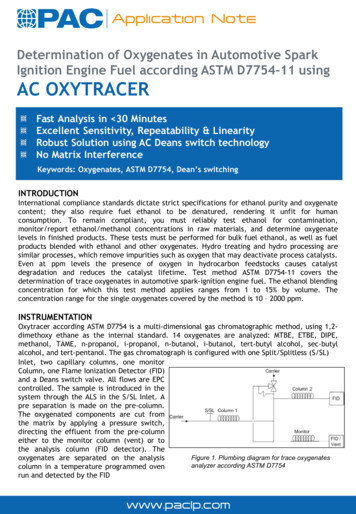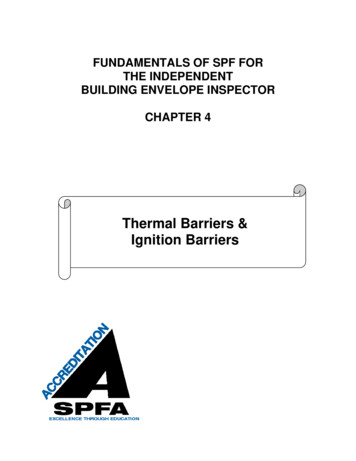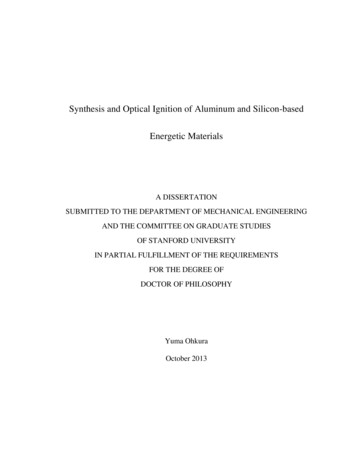
Transcription
IGNITIONINTERLOCKS:INCREASINGPARTICIPATION &PROGRAMEFFECTIVENESSTara Casanova PowellTIRF USA
OVERVIEW National annual ignition interlock survey. Evaluation of Ignition Interlock Programs:Interlock Use Analysis from 28 States, 20062011. Minnesota interlock evaluation. Michigan ignition interlock/sobriety courtevaluation. NHTSA technical assistance.2
INTERLOCK LAWS In January 2017, 28 states and 4 Californiacounties require all alcohol-impaired drivingoffenders to install an interlock. 11 states require interlocks for offenders with ahigh blood alcohol concentration (BAC) (usually0.15% or higher) and for repeat offenders.3
INTERLOCK LAWS 6 states require devices only for repeatoffenders. 1 state (NV) require devices for high-BACoffenders. 4 states do not have mandatory interlockrequirements.4
LAWS MANDATING IGNITION INTERLOCKFebruary OHOKNMMOTXVAKYSCARALGAJudicial discretion onlyRepeat offendersLAHigh-BAC offendersHIAKMDDCNCTNMSNJDEWVKSNHMARICTFLHigh-BAC first & repeatAll offenders
NATIONAL INTERLOCK SURVEY 20156
NATIONAL INTERLOCK SURVEY 2015 All 50 states and 11 manufacturers werecontacted in September 2015 to request arrestand conviction data and relevant interlock data. Counts of total installed ignition interlocks duringa period of 1 year (12 months) in 2014, and totalinstalled ignition interlocks in 2015 (January 1st toAugust 31st, 2015) were requested.7
NATIONAL INTERLOCK SURVEY 2015:DEFINITIONS Total installed number (TIN): the number ofignition interlock devices reported to be installedin vehicles over a period of time. Active installed number (AIN): the number ofignition interlock devices reported to be installedin a vehicle on the date designated by thisrequest (i.e., a snapshot in time).8
NATIONAL INTERLOCK SURVEY 2015:DATA REQUEST States were also requested to provide, ifpossible, data according to offense categories. Offense categories were defined as: 1st offender "basic" DWI; 1st offender high-BAC DWI; refused test DWI and; repeat DWI (2nd and subsequent DWI).9
NATIONAL INTERLOCK SURVEY 2015:STATE ARREST DATA DWI arrest data were requested to estimate thenumber of potentially eligible offenders in eachstate. 15 states were able to provide total DWI arrestdata for the reporting period from January 1st,2014 to December 31st, 2014. 10 of these states were able to provide furtherbreakdowns of arrest data by offense categories.10
NATIONAL INTERLOCK SURVEY 2015:STATE ARREST DATA 10 states were able to provide total DWI arrestdata for the reporting period from Jan. 1st toAugust 31st, 2015. 7 of these states were able to provide furtherbreakdowns of arrest data by offense categories.11
NATIONAL INTERLOCK SURVEY 2015:STATE CONVICTION DATA DWI conviction data were requested to furtheridentify the potential number of eligible offendersin each state. 16 states were able to provide total DWIconviction data for January 1st to December 31st,2014. 9 of these states further reported breakdowns ofconviction data by offense categories.12
NATIONAL INTERLOCK SURVEY 2015:STATE CONVICTION DATA 11 states were able to provide total DWIconviction data for January 1st to August 31st,2015. 7 of these states were able to further breakdownconviction data by offense categories. Illinois wasable to report all repeat offender DWI convictions(all 2nd and subsequent offenders).13
NATIONAL INTERLOCK SURVEY 2015:STATE INTERLOCK DATA 26 states reported interlock data. State TIN for states that reported interlock dataJanuary 1st to December 31st, 2014 was 141,787. State TIN for states that reported interlock dataJanuary 1st to August 31st, 2015 was 110,487. State AIN for states that reported interlock dataDecember 31st, 2014 was 77,909. State AIN for states that reported interlock dataAugust 31st, 2015 was 88,194.14
NATIONAL INTERLOCK SURVEY 2015:MANUFACTURER TIN DATA 8 manufacturers reported interlock data. TIN for manufacturers that reported interlockdata January 1st to December 31st, 2014 was256,150. TIN for manufacturers who reported interlockdata January 1st to August 31st, 2015 was191,479.15
NATIONAL INTERLOCK SURVEY 2015:MANUFACTURER AIN DATA AIN for manufacturers who reported interlockdata December 31st, 2014 was 309,919. AIN for manufacturers who reported interlockdata for August 31st, 2015 was 328,743.16
MANUFACTURER TIN 201417
MANUFACTURER TIN 201518
MANUFACTURER AIN DEC 31, 201419
MANUFACTURER AIN AUG 31, 201520
NATIONAL INTERLOCK SURVEY 2015:OFFENDER ELIGIBILITY Percentage of offenders who installed amongthose who were eligible or required. Dependent upon legislation, eligible offendersmay include: those arrested for a DWI (ALR requirement) or; offenders convicted of a DWI (which is dependentupon offense categories that require an interlock). This assumes that offenders are not deemedineligible for other driving violations unrelated toDWI.21
22
NATIONAL INTERLOCK SURVEY 2015:DISCUSSION Barriers that can impede states ability to providedata: data capture processes vary by agency &jurisdictions; states lack centralized or standardized datacollection; linkages between court data and DMV data arelimited; several states do not have the resources.23
NATIONAL INTERLOCK SURVEY 2015:DISCUSSION Few states could provide data other than TIN &AIN. Several states could provide data within theproject timeframe (6 months). Few states could provide a breakdown byoffense category. Accurate records and timely reporting areessential to successful interlock programs(Casanova Powell et al. 2015).24
NATIONAL INTERLOCK SURVEY 2015:DISCUSSION Implementing automated record systems andcentral repositories has been shown to improvethe availability of data in states such as Floridaand Colorado, however even these states haveroom for improvement. If more states were able to provide these data,more informative statistics could be calculatedand used to evaluate progress of state interlockprograms.25
EVALUATION OF STATE INTERLOCKPROGRAMS26
EVALUATION OF STATE INTERLOCKPROGRAMS GHSA/NHTSA/CDC funded, conducted by PRG. 3 categories of 8 keys to increase participation: Program design:– requirements & penalties. Program management:– monitoring, uniformity, coordination & education. Program support:– resources & data.27
EVALUATION OF STATE INTERLOCKPROGRAMS: CORRELATIONS OF KEYRATINGS WITH IN-USE RATES28
EVALUATION OF STATE INTERLOCKPROGRAMS: USE CHANGE RESULTS Required for 1st offenders: use increased in all 3states (FL, KS, NY). Required for repeat or high-BAC offenders: useincreased in 3 of 4 states (MI, WV, WI,decreased in VA). Required for hardship license: use increased in 2of 3 states (IL, LA, IA-no change).29
EVALUATION OF STATE INTERLOCKPROGRAMS: USE CHANGE RESULTS Interlock to reduce/eliminate license suspensionperiod: use increased in all 6 states (AR, CO, IA,OR, WA, WV) . Management and other changes: use increasedin 7 states (CA, CO, FL, MO, NM, OK, WA).30
EVALUATION OF STATE INTERLOCKPROGRAMS: SUCCESSES Legislative changes to laws and penalties: as state interlock programs evolve, states arelearning what works and what does not; many states have improved interlocklaws/programs and are working to close programgaps.31
EVALUATION OF STATE INTERLOCKPROGRAMS: SUCCESSES Monitoring offenders Data: states with a central repository allow foreasily accessible data to efficiently monitoroffenders and impose sanctions for violations in atimely manner. Uniformity and coordination: Stakeholder involvement: inter-agency task forceswhich include representatives from the judicial,administrative and law enforcement agencies.32
EVALUATION OF STATE INTERLOCKPROGRAMS: SUCCESSES Education Educating law enforcement, judges, prosecutors,probation officers, treatment providers, and driverlicensing agency staff can improve stakeholderinterest and facilitate more effective and efficientprogram implementation. Data/resources Without the ability to access reliable, shared data,program managers are unable to efficientlyexecute and evaluate their program, or monitoroffenders.33
DWI COURT INTERLOCK STUDIES Georgia: Repeat offenders graduating from DWI court were65% less likely to be re-arrested. Between 47-112 repeat arrests were prevented. Michigan (analysis of 3 counties over 2 years): DWI court participants were 19x less likely to bearrested for a DWI. Minnesota (evaluation of 9 DWI courts): Recidivism reduced 69% for high-risk participants.34
MICHIGAN DWI COURT PROGRAM Interlocks are required for participants in theMichigan DWI Court Program. An interlock must be installed after 45-day hardsuspension. Michigan DWI Court Program is geared towardrepeat offenders. An ignition interlock is required on all vehicles theDWI court participant owns/drives.35
MICHIGAN DWI COURT PROGRAM: LIMITEDDRIVING PRIVILEGE Allowed to drive to/from the person’s residence; the person’s work location; during the course of the person’s employment oroccupation as long as a commercial driver’slicense is not required; alcohol, drug or mental health education andtreatment as ordered by the court; AA/NA/MA or other court ordered programs.36
MICHIGAN DWI COURT PROGRAM: LIMITEDDRIVING PRIVILEGE Allowed to drive to/from Court hearings andprobation appointments; drug and alcohol testing; court ordered community service; an educational institution where enrolled; interlock service provider as required; medical treatment for a serious condition ormedical emergency, for themselves or a memberof their household or immediate family.37
MICHIGAN DWI COURT PROGRAM:COMPLIANCE38
MICHIGAN DWI COURT PROGRAM:INTERLOCK STUDY39
MICHIGAN DWI COURT PROGRAM: RESULTS Participants showed lower DWI and recidivismrates after 1,2,3 and 4 years. Participants were more likely to improve theirlevels of education between the entry and exit ofprogram. Participants were less likely to test positive onUA (tested more frequently). Participants incurred less jail time.40
MICHIGAN DWI COURT PROGRAM: RESULTS Fewer warrants issued for participants. Participants received higher numbers ofincentives and rewards from the courts. Participants attended more group meetings. Participants enjoyed a higher number of overalldays of sobriety. Participants had higher graduation rates (thosewho were not under interlock supervision were3.2 times more likely to be terminated from DWIcourt.41
MINNESOTA STATE INTERLOCK PROGRAMEVALUATION: IMPAIRED DRIVING ISSUE 2014-111 people killed in alcohol-related crashes. 31% of all traffic fatalities in Minnesota. 2015-137 people killed in alcohol-related crashes. 2,203 were injured. 285 million in cost. Interlock law, July 1, 2011, Statute 171.306 -Ignition Interlock Device Program.42
CURRENT LAW (MN) Voluntary: 1st and 2nd in lieu of hard revocation. Required: DWI offenders with 0.16 alcohol concentration. Any vehicle or lose driving privileges:– 1 year for 1st offense;– 2 years for 2nd offense. Repeat offenders with 3 DWIs in a 10-year periodare required to use interlocks.43
INTERLOCK PROGRAM (MN) Participants regain full or limited drivingprivileges immediately. Interlocks are used to monitor chronic DWIoffenders (3 or more DWIs in a 10-year period) toverify chemical use. Recent provision requires anyone cited for acriminal vehicle operation (CVO) “bodily harm” to“great bodily harm” to install.44
EVIDENCE-BASED PRACTICES (MN) All-offender eligibility; removal of hard suspension periods; performance-based exit; treatment, alcohol education or both. Since July 1, 2011, 23,115 drivers haveparticipated statewide.45
PARTICIPATION RESULTS (MN) Since July 1, 2011, 23,115 drivers haveparticipated statewide. Mix of voluntary and required participants. 1 in 5 eligible drivers (19.8%). 60% of DWI offenses first offenders, 9% of thesechoose to participate. 62% participants were arrested for aggravatedoffenses (BAC of 0.16 or refusals. 40.1% of those required participated.46
PARTICIPATION RESULTS (MN) Varied with age, sex and urban/rural county. Highest participation rates: men; urban counties; drivers over 45 years of age; 45–64 age group (25.2%).47
PARTICIPATION RESULTS (MN) Lowest participation rates: women; rural counties; drivers below 34 years of age (especially thosebelow 24 years of age, 3.7%). As age increases; the opportunity to meet thecriteria for mandatory program participation alsoincreases.48
COMPLETION RESULTS (MN) Just over 48% of participants have completed theprogram. More than 78% completed the program on time. The average time for successful completion is412 days. Approximately one in 100 is terminated for non-compliance. Revoked drivers (voluntary participation) 83.7%.49
COMPLETION RESULTS (MN) Canceled drivers (required participation) 27.7%completed. The more severe the DWI violations at the timeof arrest, the less likely drivers will complete theprogram. Offenders with BAC at or over 0.16 are 40% lesslikely to complete the program. Offenders who refused tests are 50.8% lesslikely to complete the program.50
RECIDIVISM RESULTS (MN) Program participants were less likely torecidivate (8%) than non-participants (20%). Only 4.5% participants recidivated during studyperiod. First offense participants were 11% less likely torecidivate. High BAC participants (over 0.16) were 8% morelikely to recidivate. Participants who refused were 29% more likely torecidivate.51
OTHER OUTCOME RESULTS (MN) Within the participant group, there are predictivefactors for success over the long term. Those who avoid failures during the program(failed start-up and rolling-retests) are more likelyto avoid recidivating after the program. The record of breath tests logged into an ignitioninterlock was effective in predicting future DWIrecidivism risk.52
OTHER OUTCOME RESULTS (MN) A failed drug test at the time of arrest resulted ina 127% elevated risk. Retention of participants within the interlockprogram allowed for increased participationrates. Interlock extensions in lieu of interlock removalwas identified as a viable alternative with regardto public safety.53
TIRF ALCOHOL INTERLOCK TECHNICALASSISTANCE TIRF has a cooperative agreement with NHTSAto provide training and technical assistance. Goals: consistently identify eligible offenders and trackprogram participation; clarify agency roles and responsibilities; streamline and strength procedures/practices; create accountability; and, manage and efficiently use resources.54
TIRF ALCOHOL INTERLOCK TECHNICALASSISTANCE Work completed (2008 - 2017) in IL, NY, SC, VT,NC, VA, WV, MD, DE, KY, ID, CA, CT, OK, MN,OR, WY, MO, NM, TS, HI, CO, ND, LA, region 3,region 7. Work ongoing in NV, AK, regional meetings: Region 4 (Alabama, Georgia, Florida).55
TIRF ALCOHOL INTERLOCK TECHNICALASSISTANCE: COMMON STRENGTHS Prohibit semiconductor sensors; some also mailin devices. Utilize certification and approval process fordevices and vendors (IL, VA, SC). Emphasis on education for lead practitioners andfor public (IL, NY, WV). Note interlock restriction on driver license. Service in rural areas (SC, WV, VA).56
TIRF ALCOHOL INTERLOCK TECHNICALASSISTANCE: COMMON STRENGTHS Standardized reporting which may/not beautomated (IL, NY, SC). Indigent funding available and rely on multiplecriteria for determination (NY, SC, VA). Inclusion of screening/assessment and treatmentfor long-term risk reduction (SC, VA, WC, NC). Use of graduated sanctions for offenderaccountability (SC, MN, VA, WV, NY). Efforts to improve communication amongagencies, including vendors (SC, VA, WV).57
TIRF ALCOHOL INTERLOCK TECHNICALASSISTANCE: COMMON CHALLENGES Lack program funding. Low participation rates: long hard suspension period; ability of offenders to opt out of program; poor communication and tracking of offenders; many requirements for program eligibility.58
TIRF ALCOHOL INTERLOCK TECHNICALASSISTANCE: COMMON CHALLENGES Paper-based reporting systems: increases workload; impedes tracking/monitoring of offenders; poor agency communication. Lack of technical knowledge: program authority unfamiliar with devices; inconsistent testing of devices; unable to keep pace with technological advances.59
TIRF ALCOHOL INTERLOCK TECHNICALASSISTANCE: COMMON CHALLENGES Removal of non-compliant offenders: contained in legislation or program rules; lack of graduated sanctions; offenders at greatest risk for recidivism are not oninterlock. Agency authority lacks flexibility: legislation too proscriptive/difficult to change; program challenges cannot be addressed; affects staff morale and support for program.60
TIRF ALCOHOL INTERLOCK TECHNICALASSISTANCE: COMMON CHALLENGES Roles and workflow are unclear: agencies lack overall understanding of program; no clear program authority; responsibilities are not clearly assigned; lack of accountability ; decision-making is agency-specific.61
TIRF ALCOHOL INTERLOCK TECHNICALASSISTANCE: COMMON CHALLENGES Limited vendor oversight: no resources or staff to manage; do not have a plan to provide oversight in relationto many different facets of program. Limited training/education in related agencies: agencies not engaged; do not understand their role in interlock delivery. Lack jurisdictional reciprocity.62
TIRF ALCOHOL INTERLOCK TECHNICALASSISTANCE: CONCLUSIONS Alcohol interlocks are a cost-effective strategy toreduce impaired driving. Legislation an important first step. More research to improve programs is needed. Implementation requires careful planning andcoordination. Justice agencies play a critical role in programs. Many jurisdictions are taking steps to strengthenpractices and procedures.63
ACKNOWLEDGEMENTS64
QUESTIONS?Email: taracp@tirf.usPhone: 203.809.870965
STAY INFORMED! CONNECT WITH US!tirf.ustirf@tirf.usFacebook.com/tirfusaincTIRF USA Inc earch-foundation-tirf66
INTERLOCK PROGRAM (MN) Participants regain full or limited driving privileges immediately. Interlocks are used to monitor chronic DWI offenders (3 or more DWIs in a 10-year period) to verify chemic
